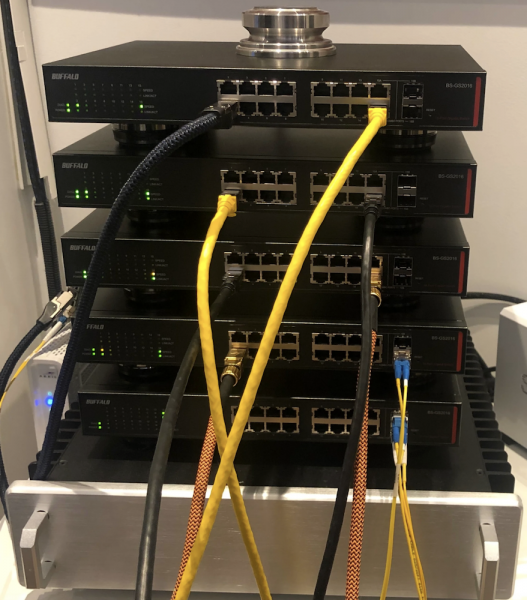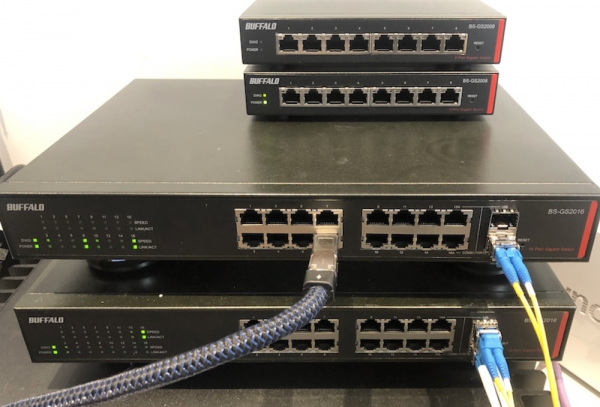Here is some background on the Buffalo / Melco switches.
The Buffalo BS-GS2016 switch was designed as a business switch. Some audiophiles in Japan figured out it's really good for audio and started modifying these switches with linear power supplies, custom configurations, etc. Buffalo then released a limited audio version of that switch for the Japanese market called Buffalo BS-GS2016A (A stand for audio I guess). It was no different than the the regular Buffalo BS-GS2016 switch, but it had the top ports disabled and some settings changed - disabled all top RJ45 ports, disabled LLDP, enabled DHCP. They included a better cable and sold it a little bit more expensive.
It's interesting that they did not use the 8-port version. The 16-port version with disabled top ports (which makes it an 8 or 9-port switch) was prefered by those Japanese audiophiles. Later on Melco also picked the 16-port version and did not expose the top copper ports. Perhaps that is because the 16-port also has SFP ports for fiber connectivity. Or perhaps there is more into it...
In February, a member of AS hinted that the board on the Buffalo BS-GS2016 looks like the board Melco used on their switch. I bought one of these Buffalo's on the next day:
https://audiophilestyle.com/forums/...eaming/page/635/?tab=comments#comment-1032742
We were curious to compare them side by side and most importantly to see what kind of clock Melco used. At the time we expected that Melco used the same board and upgraded the clock. However, the clock is hidden under the heatsink and we could not tell. A member who had the Melco switch offered to send it to me, so I can take a further look. To my surprise, I discovered that the clock on the Melco was not upgraded. I was hesitant to write much about this, from respect to Melco, and only shared this in a small circle originally. The word quickly got out, and it was not a secret anymore. I was getting hammered with messages after someone posted this publicly and decided to create a post I can point people to. Here is my post comparing the Melco and Buffalo switches:
https://audiophilestyle.com/forums/...eaming/page/651/?tab=comments#comment-1047951
The Buffalo BS-GS2016 was widely available on the US market before that post. And I managed to order a few more of those switches, which I started modifying, testing different DC cabling inside the switch, different vibration treatments, chassis damping, capacitors, different configurations, etc.
Shortly after my post, that particular Buffalo model disappeared from the US market. We can only speculate why, but I think there were multiple reasons. They were slated to go end-of-sale already. I am guessing audiophiles bought a bunch of them and emptied the local warehouses. Not sure if Melco had any influence or not. Buffalo and Melco are affiliated. I managed to buy a couple more switches from Europe. Shortly after that, they disappeared from the EU market too. Before those posts, I was able to find them for $200. After the post, I was lucky if I could get one for $300. At the end I was able to find them for $350 and the last switch I bought was $400 (because of the hefty shipping fee).
That reminds me of the PlanetTech transceiver shortage the day after Emile posted that he liked them

.
I have tried 2,3,4, and more of these switches in series.

Yes, 2 is better than 1. And 3 is better than 2. But we are talking about diminishing returns here. I would prefer two switches with better LPS than four switches with the stock SMPS. Those switches have a really noisy switching mode power supply inside. They sound super harsh with that power supply. I remove it and install a DC connector on them. Power up with a good linear power supply and they start delivering. I was able to power the switch with an Uptone Audio LPS-2.1 running at 12V, but I did not try passing any traffic, just saw it boot. But that means they consume less than 1.2A during boot. What you see on the bottom of the picture is my custom DIY Sean Jacobs DC3 LPS, which I used to power my network devices. They take about 3 weeks of non-stop running to get through the initial break-in period.
It was a bit shocking the first time I realised that the DC cable you use to power those switches (and network devices in general) makes a difference. I can easily hear the difference between different DC cables in my system. What is even more shocking is that I can easily hear a difference between two identical DC cables, one with passive JSSG360 shielding and one without. So, I started paying attention to those things. Tried all kind of different wires and my favorite one is the 15.5 AWG Mundorf silver/gold wire -
https://www.partsconnexion.com/MUNDORF-72181.html. There is a DIY DC cable recipe I have posted. You can find it
here, just follow the references. This is the best DC cable I have heard. by far! If AudioQuest or another big cable company was offering this cable, my guess is it would cost $2,000 or more. If you can solder, you can make one for $250-$300 I guess. I use the same wire as the internal hookup for the DC connector on the switch.
BTW, Marcin from JCAT was kind enough to help me figure out the pinout of the M12 Switch Gold. I just made one of these silver/gold for my friend's M12 switch and he seems thrilled.
Back to the Buffalo switch... it responds really good to vibration treatment and chassis damping too. I am now playing with various capacitors and clocks. The next step is to replace the cheap clock with a
PinkFaun ultraOCXO clock (€1250) and power up with a two rail
Sean Jacobs DC4 power supply (£3700) - one for the switch and one for the clock. I just need to find some more time for that. Then I will get a M12 Switch Gold and compare. BTW, PinkFaun installed their ultraOCXO clock on a Melco switch. The owner who I have been in touch with really liked it.
I may try to bypass the switching mode regulators too as one other person successfully did here -
https://audiophilestyle.com/forums/...-3-external-pss/?tab=comments#comment-1067961
But I have quite a few other higher priority experiments queued up before that.
Quite a few people have tried these switches, some compared them to the Melco switch, which has a bank of extra capacitors. The recollection of my stats is that from 10 people, 8 liked it a lot and 2 did not like it that much. Incidentally, the two people who did not like it had very high-end headphone systems (with the top of the line Abyss headphones I believe).
I work in the IT field and asked a few of our vendors if they can find more of these Buffalo switches for personal use. I got a message yesterday that one of these vendors may have 10 of them. I was excited that I might have found more of these at $200 per switch. But the price they gave me was close to $350 per switch after shipping. It's even more complicated that they are business to business only and not easy to buy for personal use. My initial idea was to buy all 10, keep 4 of them and pass 6 to you guys, on a first come first serve basis. But it turns out it may not be that easy or cheap as I thought.
I also have the little 8-port model. It's going through the burn-in process and will compare to the 16-port model.













